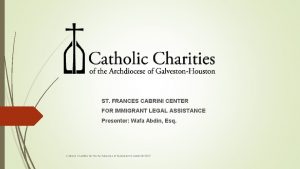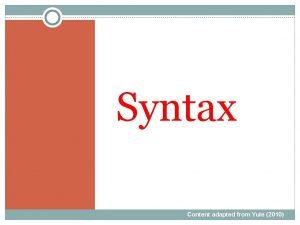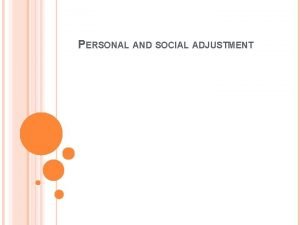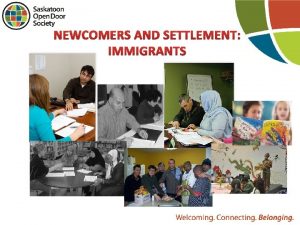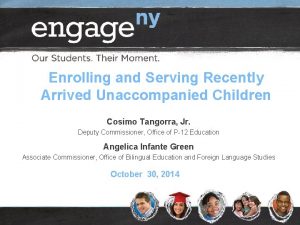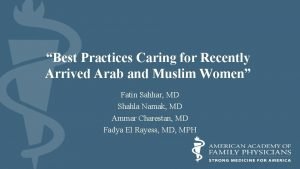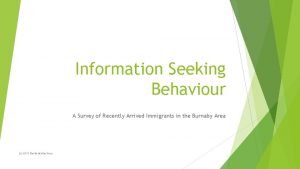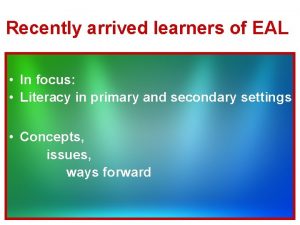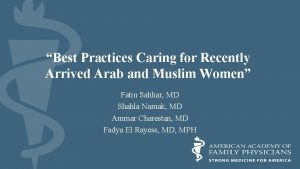A CULTURAL ADJUSTMENT GROUP FOR RECENTLY ARRIVED IMMIGRANT











- Slides: 11

A CULTURAL ADJUSTMENT GROUP FOR RECENTLY ARRIVED IMMIGRANT YOUTH: THE INVOLVEMENT OF UNIVERSITY STUDENTS Marsha Akoto, BA; Melissa Henao, BA. , Angelica Briggs, BA. , Sydney Cheron, Osairys Billini, Kuku Sekinat, MA; Bryan Alava, MA; Fernanda Moura, BA; Esther Lee, Aileen Torres, Ph. D, and Pei-Wen Winnie Ma, Ph. D Department of Psychology, William Paterson University Presentation for WPU Explorations 2020

§ Each year thousands of immigrant children and adolescents face difficulties while transitioning into a new country, including a new school environment. Immigrant students who arrive in the United States (U. S. ) during their adolescent years often face issues such as lack of English proficiency, loneliness, alienation, and changing family dynamics. § Children experience toxic stress when they are suddenly separated from their parents, which may have negative impacts in the long run. They may also be at risk at developing certain mental health disorders such as depression, PTSD, or even anxiety. § The nature of a child’s migration experience (e. g. , whether it was voluntary or forced; whether they are separated from their parents or the whole family come together) can be expected to affect the disposition toward the new culture and its people (Lustig et at. , 2004; Thibeault, Mendez, Nelson-Gray, & Stein, 2017). Background § The increased anti-immigrant and anti-Muslim rhetoric on the national stage contributed to the heightened sense of anxiety for Latinx and Muslim students in their school environment (The Southern Poverty Law Center, 2017).

• The purpose of this study is to create a schoolbased group intervention that can provide newly arrived immigrant children a place to process their experience. • The group meets once a week for twelve weeks. • Two bilingual group facilitators (master’s or doctoral students in Clinical and Counseling Psychology) led a discussion and activities around the assigned topics. The groups were conducted in Spanish, Bengali, or Arabic. Description of the Intervention

Key features of the group Activities of the intervention: • Family Tree- helps generate the discussion of family and family separation • My Fabulous Future- helps generate topics about the children’s future- career, education • Case Vignette- helps students have conversation about bullying and social problems • Jenga Game- helps students learn communication and interaction skills

• Groups were conducted at three middle schools in the city of Paterson, New Jersey. Participants • Latinx immigrant students: 35 students (21 males and 14 females), aged 10 to 15, and arrived in the United States between 1 to 48 months (mean = 12. 82, SD = 13. 44) Participants represented grades 6 (35%), 7 (29%), and 8(35%). • Muslim immigrant students: 30 students (19 males and 11 females), aged 11 to 16 (mean = 13. 90, SD =1. 09) and arrived the U. S. between 1 to 60 months ago (mean = 26. 00, SD =15. 88). Arabic adolescents (N =15) came from Jordan, Syria, Egypt, and Palestine, and Bangladeshi (N =15) adolescents were all from Bangladesh.

• The Acculturative Stress Inventory for Children (ASIC; Suarez. Morales, Dillon, & Szapocznik, 2007), which measures perceived discrimination and immigration-related stress for immigrant children. • Adolescent Resilience Questionnaire (ARQ; Guilera, Pereda, Panos, & Abad, 2015), which measures family connectedness, peer connectedness, school connectedness, and resilience. Measures • Youth Self-Report (YSR; Achenbach, & Rescorla, 2001), which assesses internalized and externalized mental health symptoms such as depression, anxiety, somatic complaints, and conduct problems. • Demographic sheet. • Exit focus group interview.

Procedures • Running the group started off with the first week of going over questionaries’ and surveys. • Some of the group members had questions regarding some of the measures. • Group leaders go over group rules, goals and process of the cultural adjustment group. • Group is conducted through various activities: discussions, role-plays, games, and arts & crafts. • A mixed-method approach was utilized to assess the effectiveness of the intervention.

Group Experience for Youth • Latinx youth participants reported on their experiences living in the United States. Participant responses revealed several critical domains including • cultural adjustment • acculturative stress • family relationships • social support • “I was a person that didn’t socialize, didn’t talk to anyone, was always in a corner and I didn’t have many friends and this year with the group I learned to forget about the problems and socialize more, meet new people that I didn’t talk to last year. ”-Latinx Student • Muslim students: • Muslim students shared their feelings about self-identity and cultural pride • Increase in social supports • Better focus in school • Improved communication with teachers and peers • “It taught us how to adjust to our situation and environment. ” “I’ve become more patient. Patient with people. ”

• The group's results from the pre-and-post tests indicated that Bangladeshi students reported a decrease in acculturative stress, whereas Latinx students reported no significant changes in this area. Discussion • Participants from both Latinx and Bangladeshi groups reported that they learned the importance to communicate with teachers, parents, and friends. • Latinx and Arabic students express an increase in self-esteem, trust, and increase in social skills. • There are perceived discrimination differences between Bangladeshi students and Latinx students.

• “Conducting the exit interview has been a great experience. In our meetings we discuss the way the groups ran and the group leaders talk about specific participants or behaviors that happen during the group. It’s one thing to hear about the participants, but my favorite part was meeting them at the end of the 10 weeks to conduct the interview. ” –Undergraduate Student Experience for undergraduate and graduate students • “Hearing how the group has really impacted them and how they wish the group lasted longer warms my heart because it makes research seem so real and worth it. ”- Undergraduate Student • “ I love helping people and I especially love being a part of a team that is working together to make a difference in the lives of our future leaders. ” – Undergraduate Students • “Hearing about how this group has given them hope for the future, or even how they overcame obstacles, or made new friendships, pushes me to get more Involved and learn more about research!”- Undergraduate student • “My experience running group was one that would change my life forever. ” – Graduate Student • “Not only did I learn about these children's experiences, but of my own being in this country with immigrant parents. They have motivated me to work harder in reaching out to the minority community to implement any help regarding mental health towards others. ”- Graduate Student

• Certain challenges of the group consisted of having to redirect the group to focus on the topic at hand. • Member's resistance Limitations • Miscommunication with school liaisons • School closings • Accommodation issues • Interruptions by administration
 Social justice definiton
Social justice definiton St patrick's college peter skrzynecki
St patrick's college peter skrzynecki Tapestri inc
Tapestri inc Immigration v emigration
Immigration v emigration Lukioil
Lukioil Cabrini center for immigrant legal assistance
Cabrini center for immigrant legal assistance I thought there was a of jealousy
I thought there was a of jealousy Scientists recently discovered that rocks collected
Scientists recently discovered that rocks collected Unfortunately they haven't been paying on time recently
Unfortunately they haven't been paying on time recently Bartling energy systems recently reported
Bartling energy systems recently reported Phrase structure rules
Phrase structure rules Fifo page replacement algorithm calculator
Fifo page replacement algorithm calculator





